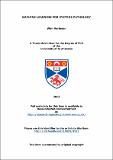Machine learning for systems pathology
Abstract
Systems pathology attempts to introduce more holistic approaches
towards pathology and attempts to integrate clinicopathological
information with “-omics” technology. This doctorate researches
two examples of a systems approach for pathology: (1) a
personalized patient output prediction for ovarian cancer and (2) an analytical
approach differentiates between individual and collective tumour
invasion.
During the personalized patient output prediction for ovarian
cancer study, clinicopathological measurements and proteomic
biomarkers are analysed with a set of newly engineered bioinformatic
tools. These tools are based upon feature selection, survival
analysis with Cox proportional hazards regression, and a novel
Monte Carlo approach. Clinical and pathological data proves to
have highly significant information content, as expected; however,
molecular data has little information content alone, and is only significant
when selected most-informative variables are placed in the
context of the patient’s clinical and pathological measures. Furthermore,
classifiers based on support vector machines (SVMs) that
predict one-year PFS and three-year OS with high accuracy, show
how the addition of carefully selected molecular measures to clinical
and pathological knowledge can enable personalized prognosis
predictions. Finally, the high-performance of these classifiers are
validated on an additional data set.
A second study, an analytical approach differentiates between
individual and collective tumour invasion, analyses a set of morphological
measures. These morphological measurements are collected
with a newly developed process using automated imaging analysis
for data collection in combination with a Bayesian network analysis
to probabilistically connect morphological variables with tumour invasion
modes. Between an individual and collective invasion mode,
cell-cell contact is the most discriminating morphological feature.
Smaller invading groups were typified by smoother cellular surfaces
than those invading collectively in larger groups. Interestingly,
elongation was evident in all invading cell groups and was not a
specific feature of single cell invasion as a surrogate of epithelialmesenchymal
transition. In conclusion, the combination of automated
imaging analysis and Bayesian network analysis provides
an insight into morphological variables associated with transition
of cancer cells between invasion modes. We show that only two
morphologically distinct modes of invasion exist.
The two studies performed in this thesis illustrate the potential of
a systems approach for pathology and illustrate the need of quantitative
approaches in order to reveal the system behind pathology.
Type
Thesis, PhD Doctor of Philosophy
Collections
Items in the St Andrews Research Repository are protected by copyright, with all rights reserved, unless otherwise indicated.

